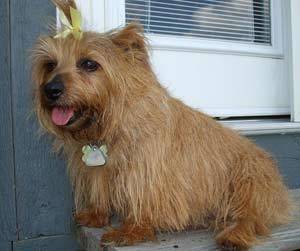“This post contains affiliate links, and I will be compensated if you make a purchase after clicking on my links.”
Description
The Norfolk Terrier is a trendy breed of strong, sturdy little dog that originated in England. It belongs to the terrier breed family which is popular for their distinct personality and exceptional hunting capability. Norfolk Terriers have been bred to become barnyard ratters. Their wiry coat comes in various colors that usually include wheaten, tan, red, black and tan, and grizzle, with or with no dark patches. Some members have white markings.
Height and Weight
Both the male and female members of the Norfolk Terrier breed normally stand a height of 10 in at the withers, and weigh 10 to 12 lbs. The breed is considered to be the smallest of the terrier dogs.
Temperament

Norfolk Terriers, in general, are stable-minded, active and courageous pets. They are easy to train, and are very affectionate toward their family owners. In fact, the breed tends to love everyone; making them excellent with children as well. Norfolk Terriers also get along well with other animals, though can be quite untrustworthy with small, non-canine pets such as rats, hamsters, and guinea pigs. Because the breed has the propensity to develop Small Dog Syndrome, owners have to display firm yet gentle, and consistent leadership over them. Otherwise, the breed will show behavior issues such as jealousy and separation anxiety. Adequate exercise also needs to be provided to keep these tiny terriers from becoming barkers and diggers.
Grooming
Norfolk Terriers basically require regular grooming. Their wiry coat needs to be stripped on an occasional basis to keep it looking beautiful. Clipping, however, is not advisable for it could ruin their coat.
Health Concerns
Members of the Norfolk Terrier breed are typically long-lived. As a matter of fact, they have an average life expectancy of about 12 to 15 years. Nonetheless, like any other canine, the breed is also susceptible to a few health issues. These include luxating patella, mitral valve disease, and hip dysplasia.
Best Environment
Because these little terriers crave for constant human companionship, they are not recommended for outdoor life. They can thrive in living in an apartment provided that they get to receive ample exercise every day. Norfolk Terriers are relatively active indoors, and will do just fine even without a yard.












